Como puedo aprobar el examen de Writing del Cambridge First Certificate? Como preparo? Lee estos consejos para saber que tienes que hacer.
Advice to pass the Cambridge First Certificate Writing Exam – What to do, and how to prepare.
First Certificate: Question 1

Read the Question
The first three things you must take into account are:
- Word count: No less than 140 words, no more than 190.
- You must mention both points mentioned above and a third point of your own.
- It is an essay. Do not treat it as an informal email. Use the appropriate language.
- Give reasons. If you say ‘I believe that fashion has an especially negative affect on young people’ you must explain why young people specifically.
If you don’t follow these, you will lose points. The examiner will suppose that you have not understood the task.
Prepare the Essay
How many words do you usually write in a paragraph. 40 – 50? That means just 3 long paragraphs, or 4 short. I recommend 4 paragraphs.
Write a very quick summary of the 4 paragraphs:
- Introduction: Why this topic is interesting/important/relevant nowadays. You can compare it quickly to 30 – 50 years ago, and so use comparatives, the past (‘used to..?) and the present perfect.
- Talk about the first point (appearance is important). Remember you have to give reasons – use examples.
- Argue the main point. The fashion industry does have a negative impact. Use the second point (price of clothes). You could also use your own point here (children could feel pressure or be bullied?)
- Conclude with your own opinion. A balanced opinion is a good idea. Try to finish with a future tense or a conditional.
Language
- Do not use colloquial language. Do not use contractions (don’t, He’s, They’re, etc.)
- Try not to repeat the same word (fashion – trends – style – vogue)
- Use all possible tenses. Don’t just write in the present tense. Plan your essay so that it includes past, future, conditionals, passives….
Marking: How to Gain (and Lose) Points
The summary I have given above is an example. There is no specific way to structure an essay, but try to make it as clear as possible, including different tenses and points of view. To see why, let’s talk about what examiners are looking for and how they mark.
There are 4 criteria: Content, Communicative Achievement, Organisation and Language. Each has a maximum of 5 points. There is a total of 20 points.
- Content
Basically this means answering the question. If you forget to include your own idea, or start talking about your neighbour’s car (or anything else that is not relevant), you will lose points.
The question you have to ask yourself is: Does the person reading this know what I question I am answering, even if he hasn’t seen it?
- Communicative Achievement
How well have you expressed your argument? What reasons have you given to your argument? Have you expressed ‘straightforward’ and ‘complex’ ideas? Have you used the right language (not too formal or informal for the task)? In the second part you may choose to do the informal email, so your choice of language has to change.
The question is: Am I using the right language for the job? Do people have a clear idea of what I am saying? Am I arguing my case well?
- Organisation
How well have you organised your argument? How have you separated your paragraphs, and what connecting words or phrases have you used? Try to include this type of phrase: First of all / Then / Moreover / Despite …ing / So / As a result….
The question is: Is there a clear but logical transition between one step in the argument and the next?
- Language
Your use of vocabulary and grammar. If you show that you have a wide range of vocabulary and include different tenses and structures, you will get full marks here.
There is a balance between doing this and not making mistakes, of course, but there is more to win than to lose. For 5 points: ‘Occasional errors may be present but do not impede communication.’. In other words, try to be ambitious.
The question you should ask yourself is: Am I showing the examiner what I can do?
Examples
OK. Now, try being the examiner. Which of these three answers got the best marks? How much did they get for each criteria? Guess, and I’ll tell you the answer below.
I imagine you have noticed some mistakes. Candidate A, for example: ‘The fashion industry say to the society…’. Candidate B: ‘..to satisfy some people needs.’ And candidate C: ‘The society we live today…’
In many essays this would mean lower marks, but remember: This is Cambridge. It is more about what you can do, or what you have done, not the mistakes you make. Think of the points in positive, not negative. So, let’s have a look at the criteria, one by one.
Content.
Did they answer the question? Did they include the two points and their own idea? Was everything relevant?
The examiners thought so. All three candidates were given a 5: maximum points for everyone! Candidate C was the most likely to get a 4, because his essay is a bit too long.
Communicative Achievement.
Was the tone correct for the task? Not too formal, not too informal? Do you understand the writer’s argument? Here there are differences between the candidates:
Candidate A only got a 2, but not because of the degree of formality. His problem is that he confuses the reader. His conclusion is that there is ‘no bad influence on people’s lives’, and yet he has not made this clear in the rest of his essay. The second paragraph is negative, and the third does not argue against it. It is possible that he did not plan his essay before writing.
Candidate B got a 3, although it could easily have been a 4. The tone is appropriate for an essay. The argument is quite clear- The introduction, a paragraph in favour, another against, and a conclusion. To see why it hasn’t got full marks, let’s look at…..
Candidate C = 5 points. The basic structure and argument is the same as Candidate B’s, but there are more ‘complex’ as well as ‘straightforward’ arguments. The ‘fashion industry is undeniably a source of profit and income.’ How does he justify this argument? ‘It hires millions of people all over the world and generates millions of dollars every year.’ That is Communicative Achievement.
Organisation
Is there a clear, yet smooth transition between points of view, between sentences and paragraphs? How well have they used linking words and phrases? Is there repetition?
Candidate A. Count how many times he has used ‘Fashion industry’. Too many. He could use pronouns (It, This), near-synonyms (designers, clothing companies, style gurus, fashion media). Apart from ‘Furthermore’, there are no linking devices. ‘In the other hand’ does not count because it is incorrect (ON the other hand…).
Candidate B gets 4 points. We have already mentioned the structure of the argument, but apart from that there is no real problem with repetition. The conclusion refers back to his argument, and there are a good deal of referring and linking words – ‘According to…’, ‘Thanks to that..’, ‘In addition…’
Candidate C gets 5 points. Again, he does the same job as Candidate B, but better. ‘In this context’ and ‘Such (a) situation’ are both good examples of a smooth transition, with references between sentences. He uses a range of linking words: ‘Nevertheless’ , ‘Furthermore’, ‘However’ ‘Moreover’, etc. There is some repetition of ‘the fashion industry’, but this is not enough to merit a 4 on its own.
Language
How well have they used language? Is there a good range of grammar and vocabulary?
Candidate A
A few good expressions (‘Some people claim’ or ‘extremely high’), but a limited use of grammar, with some mistakes with the third person singular (‘The fashion industry say…’). Practically the whole text is in the present simple, although there is a modal (should) and a passive (‘was created’) which is positive. However, the candidate does not show much more than a basic level of English. 2 points.
Candidate B
Candidate B shows many of the same aspects as Candidate A. Some good phrases (‘can increase the price of clothes’, ‘forcing people who don’t want to be’), some mistakes with the third person singular (‘this industry design beautiful clothes…’). Again, it is over-reliant on the present simple, although there are some modals (should and must).
Candidate C
A wide range of vocabulary which is used appropriately (‘is characterised by’; ‘at a blink of an eye’; ‘paramount role’; ‘undeniably’; ‘enhancing’; ‘neither impressed nor motivated’; ‘in detriment to’) and more complex grammar (present continuous=’is becoming’; passive=’is also believed to be able’; ‘it is stated’; ‘it is thought’) although there is no use of past and future tenses. There are some mistakes, but they occur when more ambitious or complex structures are attempted, and therefore not viewed so negatively. 5 points!
Candidate A = 11/20
Candidate B = 15/20
Candidate C = 20/20
Before Finishing
Just a few points before I give you some homework:
- The Writing Exam lasts 1 hour 30 minutes and has two parts of the same length. In other words, 45 minutes for each part.
- Don’t start writing until you have prepared a structure. You will save time and your essay will be much better.
- As a personal recommendation, I would write a first version, changing it as much as I like before writing a clean version on the answer sheet.
- Be ambitious – It is better to use complex grammar and make some mistakes than have a basic answer, even if it is perfectly correct.
Practice
It’s your turn! Look at this question and write your essay into the comments box below. I will make my comments on it. Remember to respect the word count and the time available (45 minutes).
Good luck! I look forward to your answers….



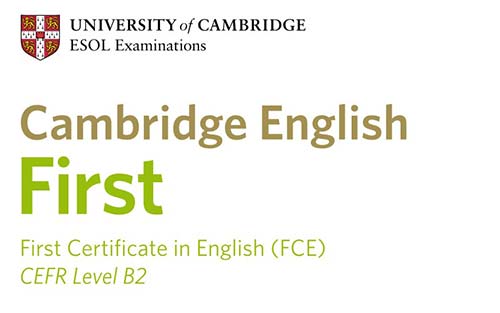
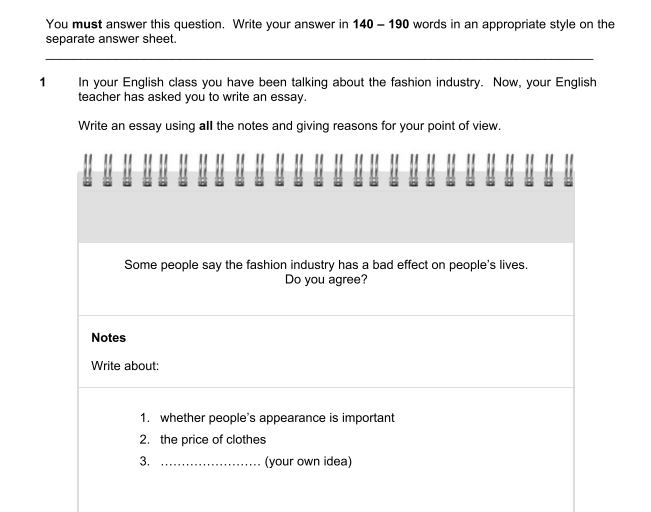
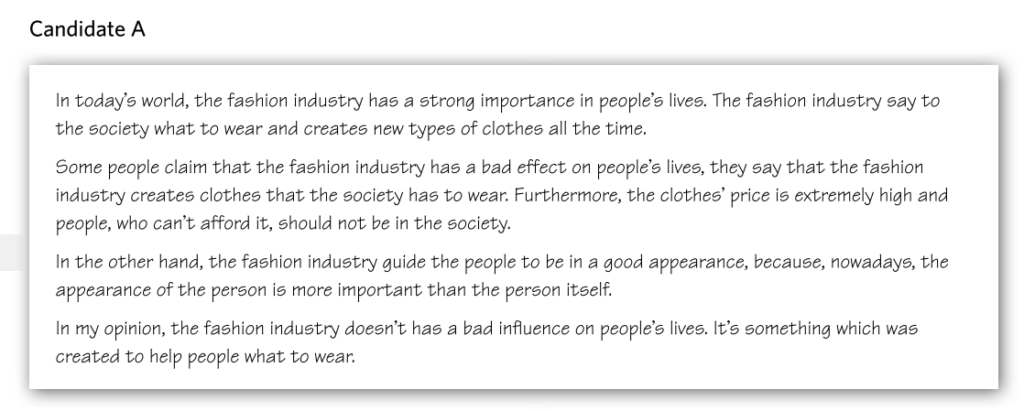
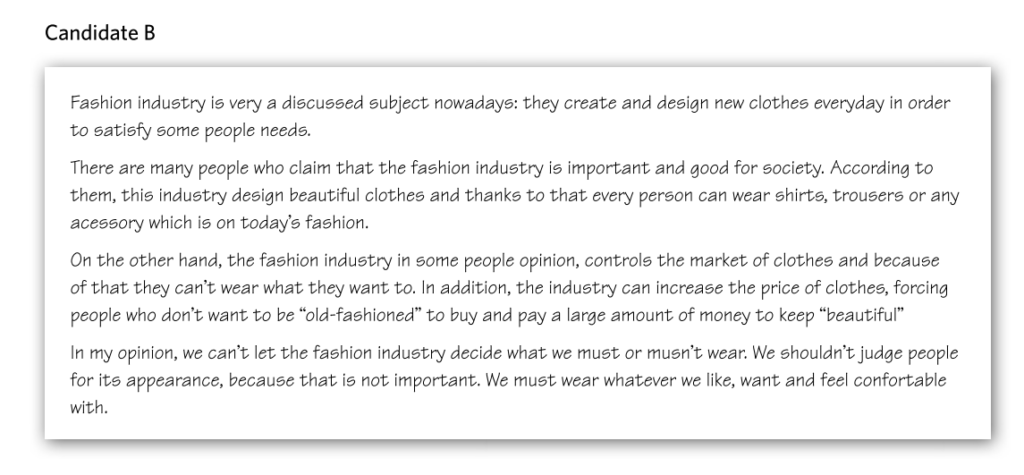
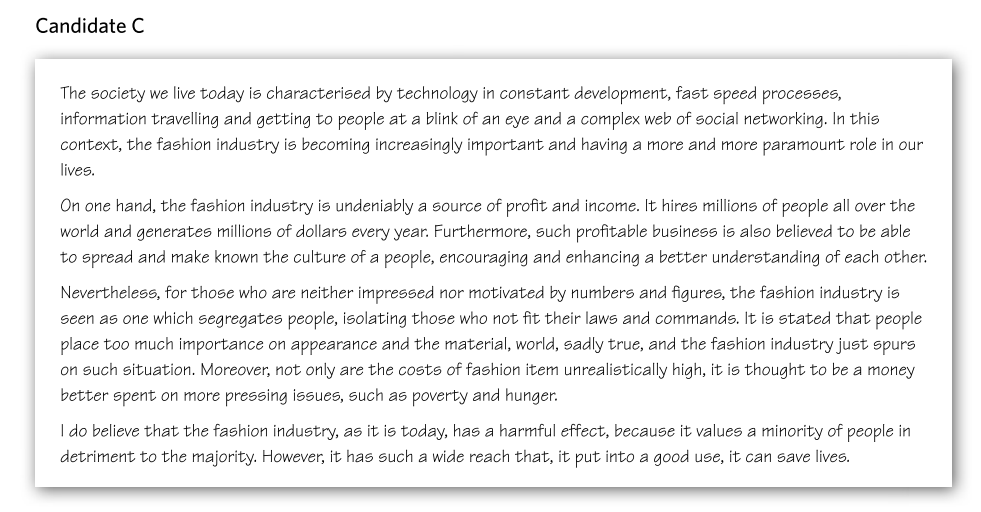
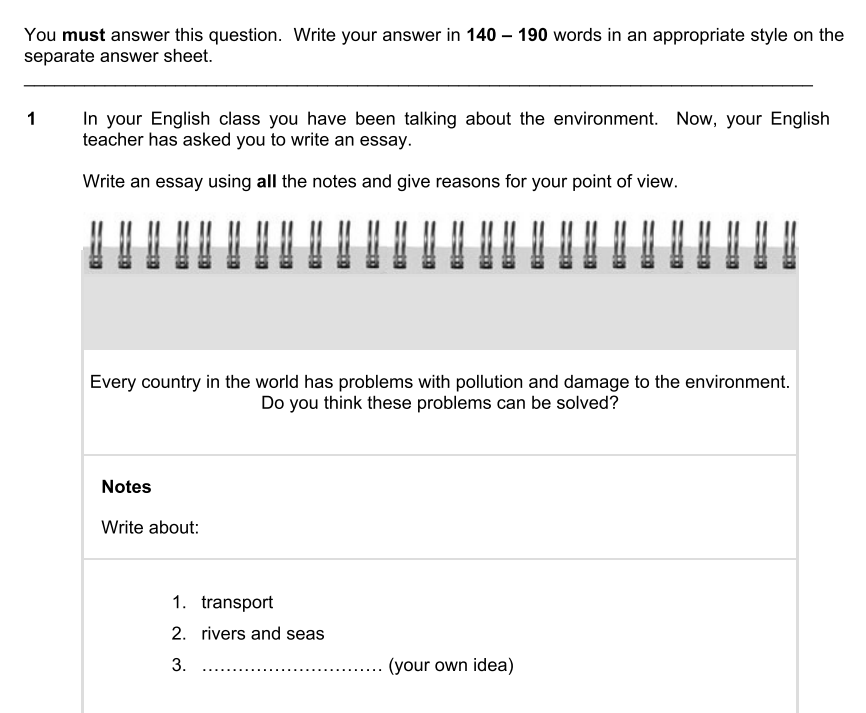




Leave a Reply